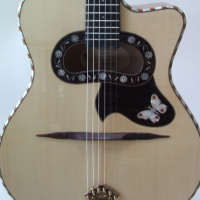DjangoBooks.com
Welcome to our Community!
Categories
- 20K All Categories
- 1.1K General
- 475 Welcome
- 59 Archtop Eddy's Corner
- 146 CD, DVD, and Concert Reviews
- 383 FAQ
- 26 Gypsy Jazz Italia
- 25 Photos
- 202 Gypsy Picking
- 21 Unaccompanied Django
- 15 Pearl Django Play-Along Vol.1
- 17 Gypsy Fire
- 45 Gypsy Rhythm
- 1.4K Gypsy Jazz University - Get Educated
- 130 Gypsy Jazz 101
- 223 Repertoire
- 218 History
- 707 Technique
- 51 Licks and Patterns
- 6 Daniel Givone Manouche Guitare Method Users Group
- 20 Eddie Lang Club
- 1.3K Gypsy Jazz Gear
- 800 Guitars, Strings, Picks, Amps, Pickups and Other Accessories
- 457 Classifieds
- 49 Recording
- 62 Other Instruments
- 18 Violin
- 5 Mandolin
- 22 Accordion
- 7 Bass
- 10 Woodwinds
- 345 Gypsy Jazz Events
- 141 North America
- 109 Europe
- 95 International
In this Discussion
3rd 'G' string
Has anybody tried a plain--unwound-- 3rd G string, as it appears the 3rd wound string that dies first? (On gypsy strings that is.) I do know that a wound 3rd does add more depth to the string but if you did use a plain 3rd what string gauge did you use? Did it suit the guitar? Your thoughts on the subject?












Comments
Huh I didn't know the G string was known for that...for me, it's pretty much always the high E, although I have noticed the B and G tend to go stale more quickly now that I'm using way more vibrato than I used to.
Anyway, don't have an answer to your question but I do remember trying an unwound G way back in the day on a flat top and if memory serves it was pretty bad...or certainly enough that I never considered repeating it again haha
Remi Harris does this - he puts electric guitar strings on G B and E.
That seems like a bad idea. Obviously not an expensive experiment. But I don't foresee that sounding great.
The unwound-G in an acoustic set seems to run in the 018-022 range, while the Argentine wound Gs are nominally 022-025. (The actual gauges, according to the Savarez website, are actually a bit smaller.) For a 670-mm/26.3-inch scale, that means tension runs about 27 pounds (again, from the Savarez site), while a 020 unwound is just over 26 pounds and a 022 is over 31 (I used the Stringjoy calculator). That tension difference probably means a difference in feel and, I suspect, tone as well.
FWIW, I've noticed that the most likely Argentine string to fail is the G--probably a combination of its structure (wound and thus subject to wear on the windings) and tension (highest in the set). Unwound strings always wear longer, though in light sets the E might tend to break most often.
There's an Ernie Ball set of acoustic strings that starts with a 10 for the first string and has an unwound 17 for the third string.
What kind of a baby plays a normal abusive guitar with 10s?